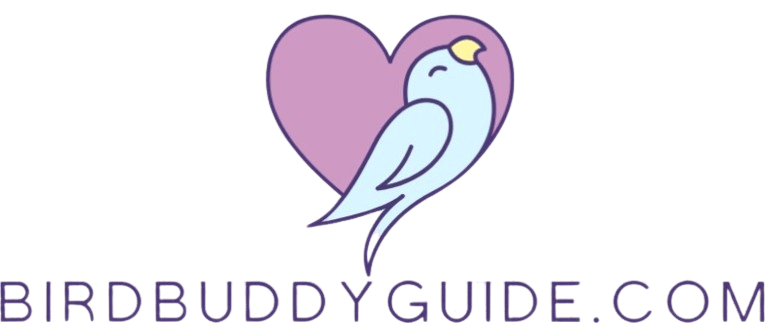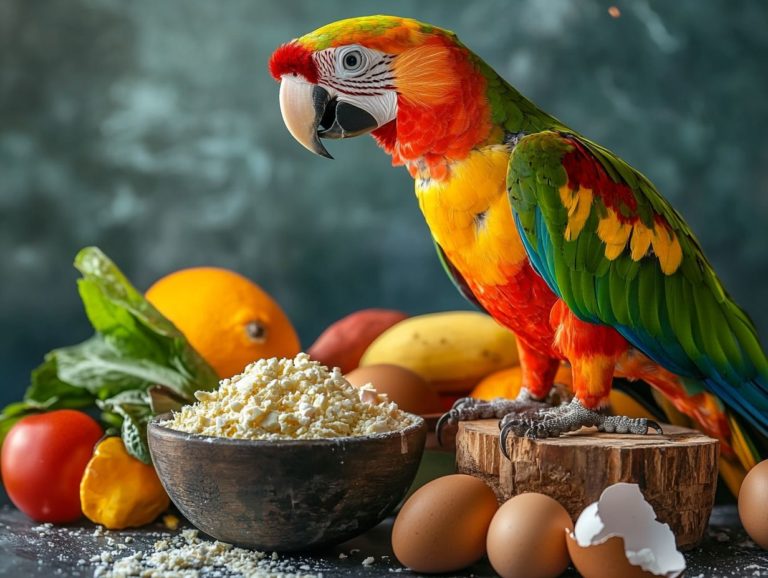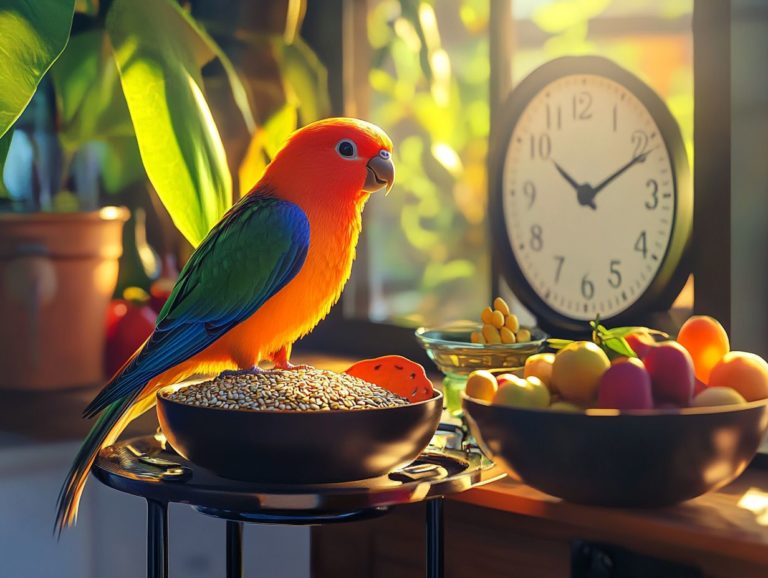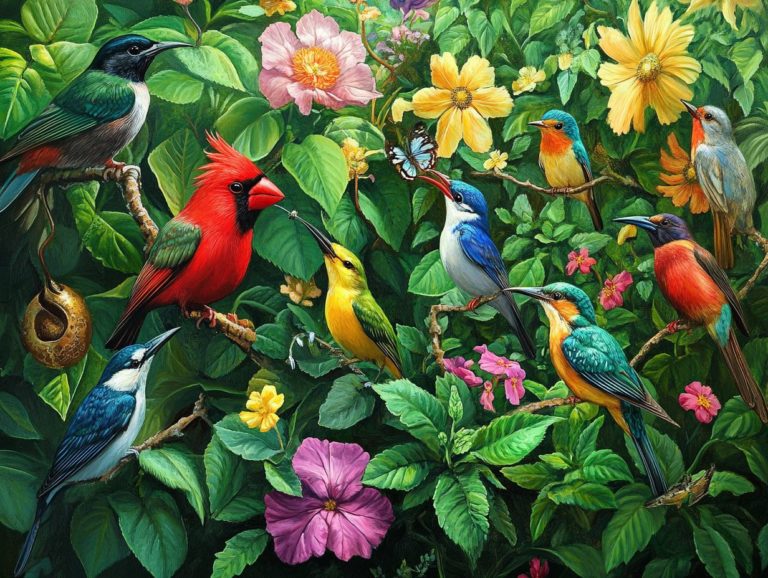5 Birds with Unique Dietary Needs
Birds are among nature’s most captivating creatures, and their dietary habits unveil a remarkable world of adaptation and specialization.
From the vibrant hummingbird delicately sipping nectar to the majestic eagle skillfully hunting small mammals, each species has crafted a unique diet essential for its survival.
This exploration delves into five extraordinary birds and their distinctive eating habits, revealing how their diets influence their behavior, habitat, and nutritional needs.
You ll discover the challenges these birds encounter in captivity and learn how you can play a part in their conservation.
Prepare to uncover the fascinating diets of these feathered friends!
Contents
Key Takeaways:
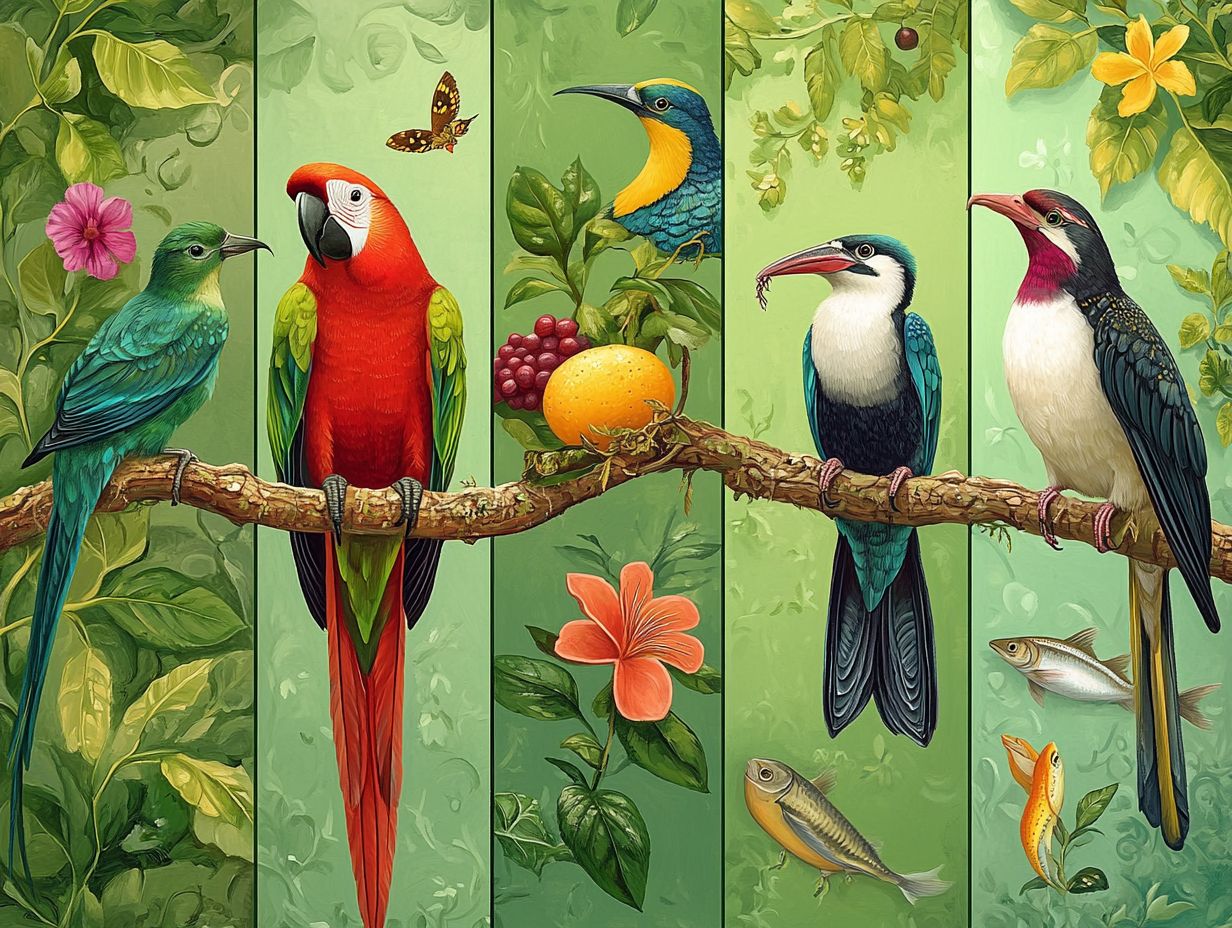
- Hummingbirds have unique dietary needs, relying on nectar and insects for their energy and nutrition.
- Penguins have a diet of fish and krill, providing them with the necessary fat and protein for their cold and aquatic habitats.
- Flamingos have a specialized diet of algae and invertebrates, giving them their distinctive pink color and helping them filter feed.
1. Hummingbirds: Nectar and Insects
Hummingbirds are captivating creatures, admired for their distinctive dietary requirements, which focus on nectar from flowers and small insects. This unique diet provides them with essential nutrients for their high-energy lifestyle.
These diminutive birds depend on the sugars present in nectar as their main source of carbohydrates, fueling their rapid wing beats and remarkable agility in flight. They also need protein from small insects and arachnids, vital for muscle maintenance and growth.
Maintaining a balanced diet is crucial for their well-being. Avian veterinarians assess their dietary intake, ensuring these birds receive the proper amounts of carbohydrates and proteins. Regular check-ups and dietary evaluations can help prevent potential health issues, allowing them to flourish in their natural environments.
2. Penguins: Fish and Krill
Penguins thrive on a diet rich in fish and krill, essential sources of protein and omega-3 fatty acids. These nutrients are crucial for supporting their complex anatomy and overall well-being.
Fish and krill are also loaded with important vitamins like B12, crucial for energy metabolism, and minerals like selenium that play a significant role in antioxidant defense. The specific fatty acids found in their meals boost brain function and promote healthy skin and feathers.
By indulging in a varied diet of local aquatic life, these remarkable birds ensure they receive the balanced nutrition necessary for optimal growth, reproduction, and endurance, preventing protein deficiency.
This dietary preference highlights their remarkable adaptability and resilience, key traits that enhance their survival in unpredictable climates.
3. Flamingos: Algae and Invertebrates
Flamingos are fascinating birds that dazzle us with their vibrant colors! Their striking appearance comes from a diet largely made up of algae and invertebrates, rich in natural pigments.
These birds have evolved specially adapted beaks that allow them to filter-feed effectively, expertly sifting through water for tiny organisms and plant matter. As they forage, they separate nutritious morsels that contribute to their vibrant colors while providing vital nutrients for their overall well-being.
The natural pigments in their diet enhance their coloration and bolster their immune systems, fertility, and overall vitality.
However, environmental changes such as pollution and habitat loss threaten their survival, making it crucial for us to act now to protect these incredible birds!
Join us in protecting these amazing species every action counts!
4. Eagles: Fish and Small Mammals
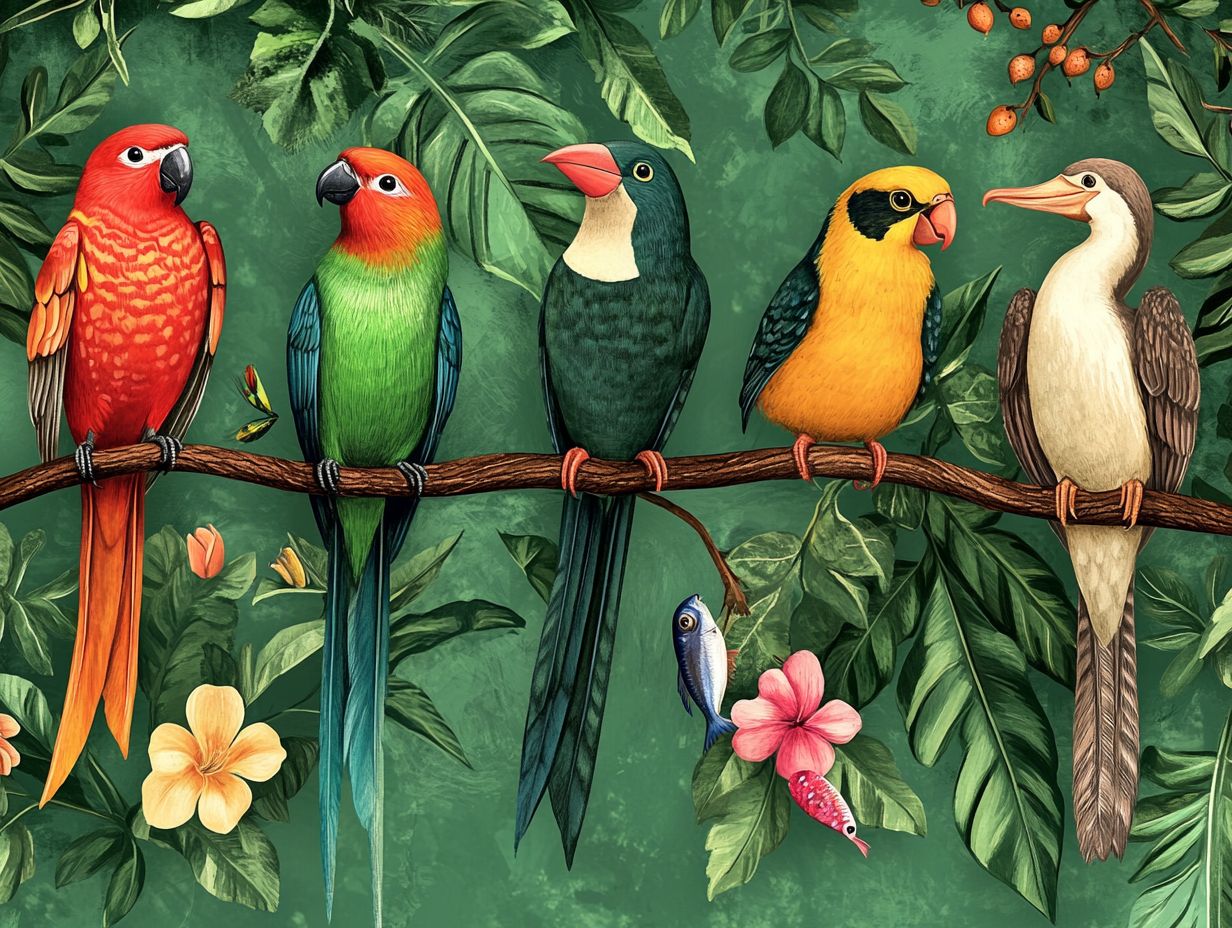
Eagles stand as top hunters, often indulging in a diet of fish and small mammals that showcases their exceptional hunting skills. This diet is rich in protein and vital for supporting their powerful physiques and high-energy lifestyles.
With keen eyesight, these magnificent birds can spot prey from impressive heights. They utilize a range of techniques think high-speed dives and surprise attacks to secure their meals effectively. This varied diet brings essential fatty acids into their systems, greatly contributing to their overall vitality and well-being.
How eagles manage their feeding is fascinating. They often consume larger portions following successful hunts. This helps maintain their energy levels and promotes optimal health. By relying on a diet that includes healthy fats, they bolster their immune function and reproductive success, underscoring the crucial connection between their diet and survival in the wild.
5. Toucans: Fruits and Insects
Toucans are vibrant birds that thrive on a diet rich in fruits and insects. This diverse menu satisfies their unique dietary preferences and ensures they get essential vitamins, like vitamin C.
Imagine them indulging in a feast of figs, berries, and a variety of tropical delights, while also munching on insects that provide the vital proteins necessary for their growth and energy. This balance is crucial for their health and vitality, impacting their ability to thrive in the wild.
A well-rounded diet supports their stunning plumage and plays a significant role in their social behaviors, mating rituals, and foraging strategies. Understanding the importance of variety in bird diet is essential for their survival and reproductive success in natural habitats.
What Makes These Birds’ Diets Unique?
The diets of various bird species, like hummingbirds, penguins, flamingos, eagles, and toucans, are finely tuned to meet their unique nutritional needs and ecological roles. However, bird owners can sometimes overlook important aspects of their pets’ diets. Understanding these common dietary mistakes can help showcase the amazing variety of bird diets!
Take hummingbirds, for example. They depend heavily on nectar, which delivers quick energy from carbohydrates essential for their high metabolic rates. Eagles, on the other hand, embrace a carnivorous diet filled with proteins and fats that enhance their hunting skills and muscle strength. Flamingos filter-feed on brine shrimp and algae, drawing in crucial carotenoids that contribute to their vibrant plumage.
Understanding these dietary differences supports conservation efforts for these species and reveals the deep connections between their eating habits, behavioral traits, and ecological interactions within their environments.
How Do These Birds Obtain Their Unique Diets?
The unique diets of avian species are crafted through specialized feeding practices and ecological adaptations that enable them to efficiently tap into their available food sources. Incorporating superfoods for a healthier bird can further ensure their nutritional needs are met.
These adaptations can take many forms. Consider the long, curved beaks of nectarivorous birds; they re designed perfectly for sipping the sweet nectar hidden within flowers. On the other hand, seed-eaters boast sharp, stout bills that make cracking tough shells easy, highlighting the significance of dietary variations.
Habitat selection is equally critical. Some species thrive in areas abundant with their preferred foods, such as lush wetlands or dense forests, while others migrate seasonally to take advantage of changing food availability. For example, insectivorous birds often shift their territories in spring to locations where insects are plentiful, illustrating the dynamic relationship between food sources and avian life.
Discover how you can help protect these amazing species!
What Are the Nutritional Requirements for These Birds?
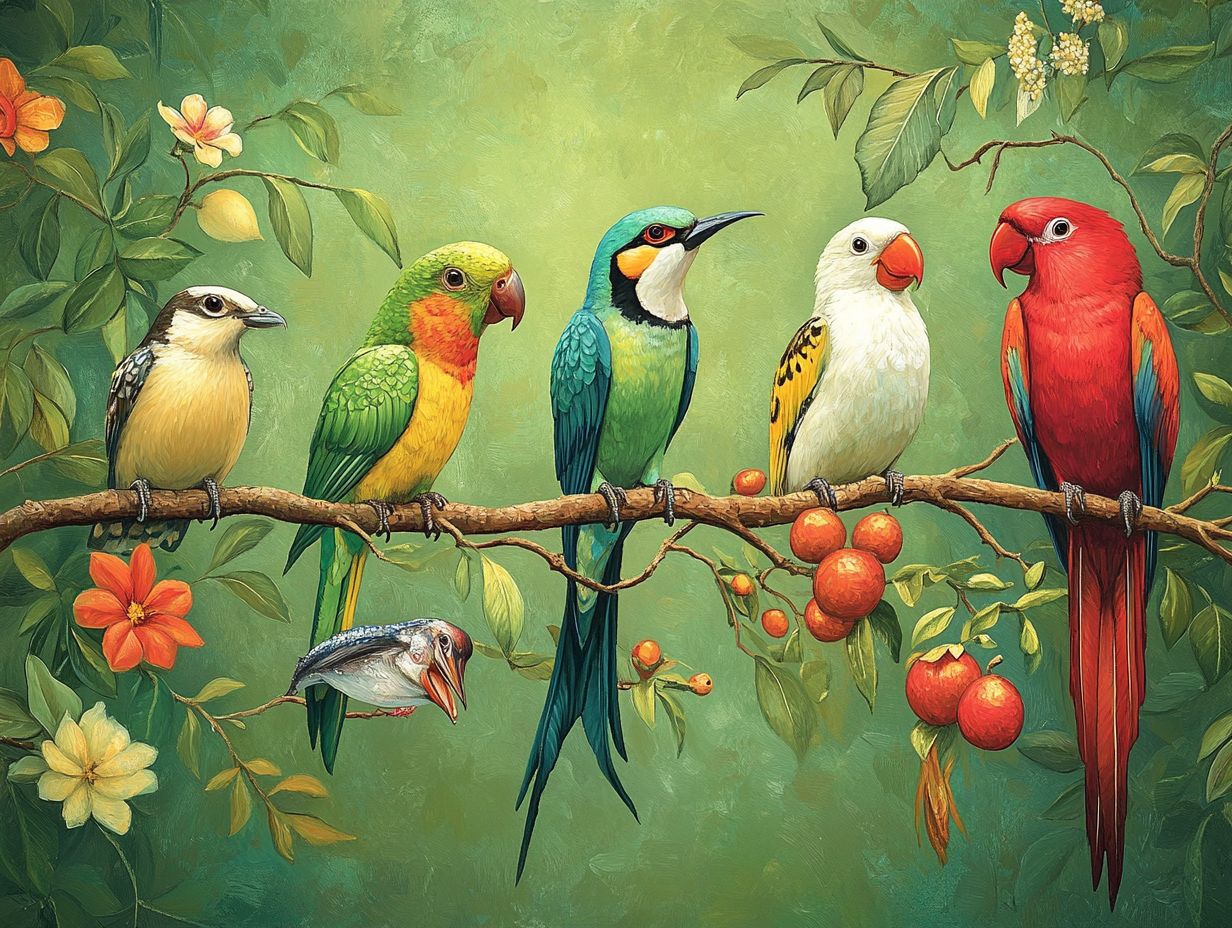
Understanding the nutritional requirements of various avian species is essential for maintaining their health. These birds depend on a balanced intake of vital vitamins, proteins, and minerals to support their intricate anatomy and overall well-being. For more insights, consider the 5 key factors for choosing bird food.
Take vitamin A, for example; it s crucial for maintaining good vision and a strong immune system. Vitamin D is essential for calcium absorption and bone health particularly vital for heavier species. Meanwhile, vitamin E serves as an antioxidant, protecting cells from damage, while vitamin K plays a key role in blood clotting.
Protein needs can vary greatly, supporting muscle development and repair. This makes it a fundamental component for active species. Let s not overlook calcium, which is absolutely essential, especially for egg-laying birds. It ensures strong eggshell formation and helps prevent potential health complications.
How Do These Birds’ Diets Affect Their Behavior and Habitat?
The diets of these avian species play an important role in shaping their behavior and habitat choices. Understanding how to create a bird-friendly diet plan can help us appreciate how their feeding patterns and nutritional needs determine where they thrive and how they engage with their surroundings.
For example, species that primarily feast on insects often display foraging behaviors that draw them to lush environments rich in vegetation. In contrast, seed-eating birds tend to gravitate toward open fields or forests abundant in seeds. These dietary habits affect their social interactions during mating. For example, showing off food sources can indicate a bird’s health.
The ecological consequences of their dietary habits extend far beyond their immediate environment. They affect plant reproduction, pest control, and the intricate structure of food webs. This shows how closely diet and environmental health are connected.
What Are the Challenges of Meeting These Birds’ Dietary Needs in Captivity?
Meeting the dietary needs of birds in captivity is a big challenge! It’s crucial to mimic their natural diets to prevent nutritional deficiencies and keep them healthy. For more specific information, check out the unique needs of Amazon parrots.
Navigating the unique dietary requirements of various species can feel overwhelming. These needs can vary based on factors like age and health condition. You might find yourself grappling with misinformation or a scarcity of resources on the right types of seeds, fruits, and vegetables that are necessary for optimal nutrition. This underscores the critical importance of nutritional education, including understanding the 5 essential nutrients for bird health, enabling you to make informed choices about your birds’ diets.
Use good feeding strategies. Monitor food intake and offer a variety of high-quality pellets to keep your birds healthy. By employing these effective feeding strategies, you can make a real difference in your birds health and happiness!
How Can We Help Conserve These Birds and Their Unique Diets?
Conservation efforts focused on protecting bird species and their unique diets are essential for maintaining ecological balance. Habitat protection and restoration directly impact the availability of critical food sources that these birds depend on for survival.
These initiatives encompass a range of sustainable practices. Restoring natural habitats compromised by human activity ensures birds have access to the plants and insects they need.
Education plays a vital role in fostering an understanding of dietary preferences. This includes the importance of essential vitamins, like vitamin A and vitamin E, which influence how communities approach their food choices and waste management.
Join local efforts, like tree planting and clean-up drives, to protect bird habitats and connect with your environment! This collaborative approach cultivates a more harmonious relationship between humans and wildlife, benefiting both parties.
Frequently Asked Questions
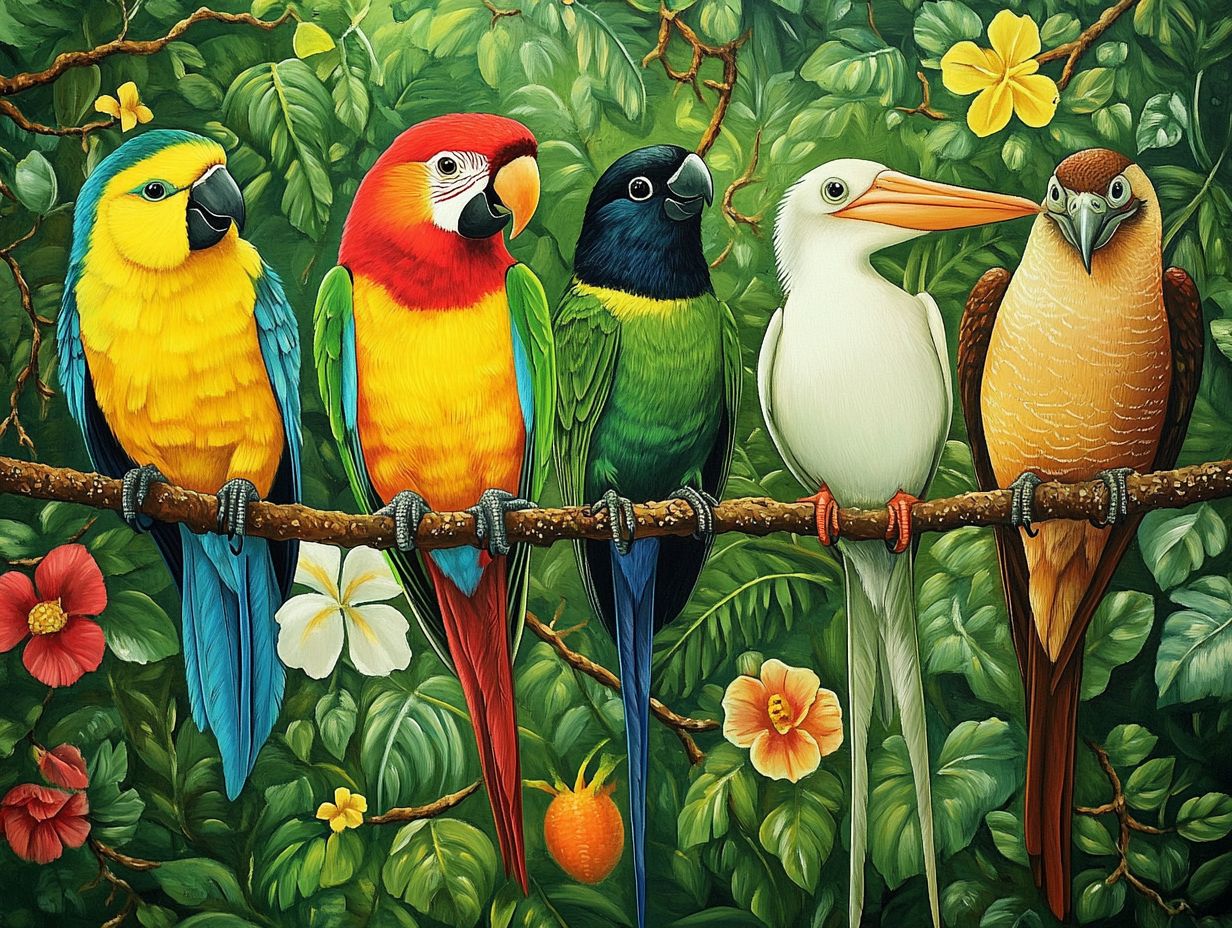
What are the five birds with unique dietary needs?
The five birds with unique dietary needs are the hummingbird, the pelican, the owl, the penguin, and the parrot. Each requires careful attention to their dietary variations and essentials in bird nutrition for optimal health.
What type of food should I feed a hummingbird?
Hummingbirds primarily eat nectar from flowers and insects like flies and spiders. Their optimal diet is rich in natural sugars and essential nutrients.
Do pelicans have any specific dietary requirements?
Pelicans primarily eat fish, especially those rich in omega fatty acids. They also require a diet high in calcium to support their large beaks, which are essential for their feeding practices.
What do owls eat?
Owls are carnivorous birds and mainly eat small mammals, such as rodents, along with insects and other birds. This diet provides them with the necessary protein and essential minerals.
What are the dietary needs of a penguin?
Penguins mainly eat fish and krill, which are high in protein and healthy fats. This high-fat diet helps them stay warm in cold weather, which is crucial for their health.
Can I feed my parrot just seeds and nuts?
No, parrots have a varied diet and should also be fed fruits, vegetables, and some grains to meet their nutritional needs. This includes high-quality pellets and specialized nutrients for optimal parrot health.
